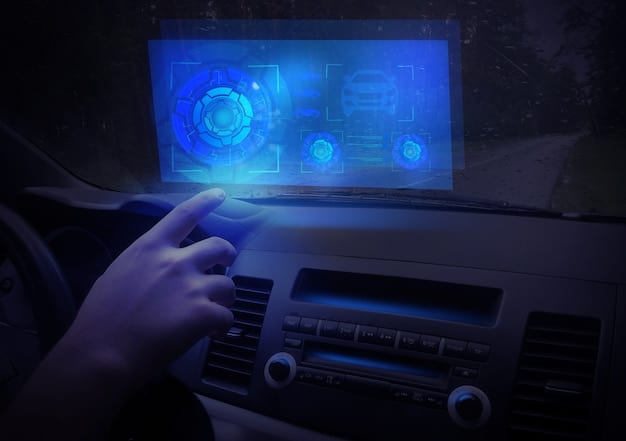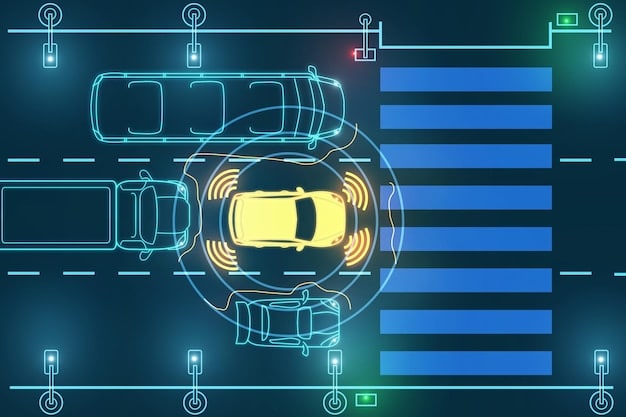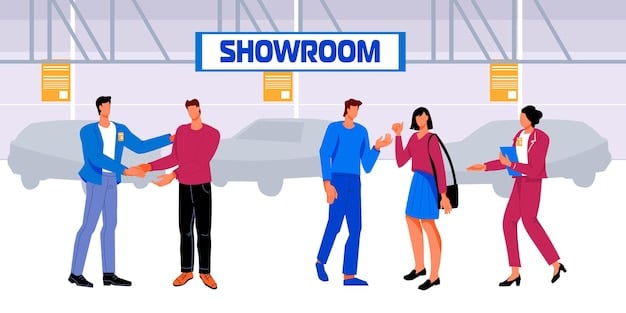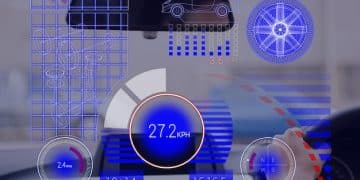How US Automakers Gear Up for Over-the-Air Software Updates

US automakers are strategically preparing for the shift towards over-the-air (OTA) software updates by investing in robust software platforms, enhancing cybersecurity measures, and forging partnerships with tech companies to ensure seamless and secure vehicle updates.
The automotive industry is undergoing a significant transformation, and **how US automakers are preparing for the shift towards over-the-air (OTA) software updates** is a crucial aspect of this evolution. As vehicles become more connected and software-dependent, the ability to remotely update and improve vehicle systems is becoming a competitive necessity.
The Rise of Software-Defined Vehicles
The automotive industry is no longer just about mechanics; it’s increasingly about software. Modern vehicles are complex systems with numerous electronic control units (ECUs) that manage everything from engine performance to infotainment.
These software-defined vehicles require continuous updates and improvements to address bugs, enhance features, and even add entirely new functionalities. This is where over-the-air (OTA) updates come into play, offering a convenient and efficient way to keep vehicles up-to-date without requiring a visit to the dealership.
The Benefits of OTA Updates
OTA updates offer several advantages for both automakers and consumers:
- Improved vehicle performance and reliability
- Faster bug fixes and security patches
- New feature deployments without hardware changes
- Reduced warranty costs for automakers
Challenges in Implementing OTA Updates
Despite the benefits, implementing OTA updates is not without its challenges. Automakers need to address several key issues:
- Ensuring cybersecurity and preventing unauthorized access
- Managing data transmission and storage
- Testing and validating updates to avoid system failures
- Providing a seamless user experience during the update process

Addressing these challenges requires a strategic approach that encompasses technology, infrastructure, and organizational changes. Automakers are investing heavily in these areas to prepare for the future of software-defined vehicles.
Investing in Robust Software Platforms
One of the primary ways US automakers are preparing for the shift towards OTA updates is by investing in robust and scalable software platforms. These platforms serve as the foundation for managing and delivering software updates to vehicles.
A modern software platform for OTA updates needs to be versatile, secure, and capable of handling a large volume of data. It should also be designed to integrate seamlessly with existing vehicle systems.
Key Components of a Software Platform
These platforms typically include the following key components:
- Centralized data management system
- Secure communication protocols
- Advanced testing and validation tools
- User-friendly update management interface
Examples of Automaker Investments
Several US automakers have made significant investments in building or acquiring software platforms for OTA updates:
- General Motors has developed its Ultifi software platform
- Ford has partnered with Google to integrate Android Automotive
- Tesla has built its own proprietary software platform from the ground up
These investments reflect the growing recognition that software is a critical differentiator in the automotive industry.
Enhancing Cybersecurity Measures
Cybersecurity is a paramount concern when it comes to **OTA software updates**. The ability to remotely update vehicle systems also opens up potential vulnerabilities that malicious actors could exploit.
US automakers are taking cybersecurity very seriously, implementing a range of measures to protect against cyber threats and ensure the integrity of their software updates.
Importance of Secure Communication
Secure communication protocols are essential for preventing unauthorized access to vehicle systems. Automakers are using encryption, authentication, and other security measures to ensure that only authorized updates can be installed.
Cybersecurity Best Practices
In addition to secure communication, automakers are following cybersecurity best practices, such as:
- Regularly scanning for vulnerabilities
- Conducting penetration testing
- Implementing intrusion detection systems
- Collaborating with cybersecurity experts
Industry Standards and Regulations
Automakers are also working to comply with industry standards and regulations, such as the Automotive Information Sharing and Analysis Center (Auto-ISAC) and the National Highway Traffic Safety Administration (NHTSA) guidelines.
By prioritizing cybersecurity, US automakers are building trust with consumers and protecting their vehicles from potential cyber attacks.
Forging Partnerships with Tech Companies
The shift towards OTA updates requires expertise in software, data management, and cybersecurity. US automakers are increasingly forging partnerships with tech companies to fill these gaps and accelerate their progress.
These partnerships can take various forms, including joint ventures, technology licensing agreements, and strategic investments.
Benefits of Partnerships
The benefits of these partnerships are numerous:
- Access to cutting-edge technology
- Expertise in software development and data management
- Faster time to market for new features and updates
- Shared costs and risks
Examples of Partnerships
Several notable partnerships have emerged in recent years:
- Ford’s partnership with Google to integrate Android Automotive
- General Motors’ collaboration with Microsoft on cloud computing
- Stellantis’ partnership with Foxconn on software and hardware development

These partnerships are helping US automakers stay competitive and innovate in the rapidly evolving automotive landscape.
Training and Developing Talent
The shift towards software-defined vehicles requires a skilled workforce with expertise in software development, data science, and cybersecurity. US automakers are investing in training and developing talent to meet this demand.
This includes providing training programs for existing employees, hiring new graduates with relevant skills, and partnering with universities and technical schools to develop automotive software curriculum.
Internal Training Programs
Many automakers have established internal training programs to upskill their existing workforce. These programs cover topics such as:
- Software development methodologies
- Data analytics and machine learning
- Cybersecurity best practices
Recruiting and Hiring
Automakers are also actively recruiting and hiring talent from tech companies and universities. This includes software engineers, data scientists, and cybersecurity experts.
Partnerships with Educational Institutions
To build a long-term pipeline of talent, automakers are partnering with universities and technical schools to develop automotive software curriculum. This ensures that students are equipped with the skills needed to succeed in the modern automotive industry.
By investing in talent development, US automakers are ensuring that they have the expertise needed to develop and deploy OTA updates effectively.
Future Trends in OTA Updates
The evolution of OTA updates is far from over. Several future trends are expected to shape the way automakers manage and deliver software updates to vehicles.
These include:
- Personalized Updates: Tailoring updates to individual driver preferences and needs.
- Predictive Maintenance: Using data from OTA updates to anticipate and prevent maintenance issues.
- Subscription-Based Features: Offering new features and functionalities through subscription services.
Personalized Updates
Personalized updates will allow automakers to deliver software updates that are tailored to individual driver preferences and needs. For example, a driver who frequently uses a particular feature may receive updates that enhance that feature.
Predictive Maintenance
Data collected from OTA updates can be used to predict potential maintenance issues before they occur. This will allow automakers to proactively address problems and reduce downtime for vehicle owners.
Subscription-Based Features
Automakers are exploring the possibility of offering new features and functionalities through subscription services. This would allow drivers to customize their vehicles with the features they want and pay for them on a monthly or annual basis.
These future trends promise to further enhance the value of OTA updates for both automakers and consumers.
| Key Point | Brief Description |
|---|---|
| 💻 Software Platforms | Investing in robust software platforms for managing and delivering OTA updates. |
| 🛡️ Cybersecurity | Enhancing cybersecurity measures to protect against cyber threats and ensure data integrity. |
| 🤝 Partnerships | Forging partnerships with tech companies to gain expertise and accelerate innovation. |
| ⚙️ Talent Development | Training and developing talent to meet the growing demand for software expertise. |
FAQ Section
▼
OTA updates are software updates that are delivered wirelessly to a vehicle, similar to how updates are delivered to smartphones and computers, without needing a physical connection.
▼
OTA updates enable automakers to quickly fix bugs, improve vehicle performance, add new features, and enhance cybersecurity, reducing costs and increasing customer satisfaction efficiently.
▼
Automakers use encryption, authentication protocols, and regular security audits to protect OTA updates from unauthorized access and cyber threats, ensuring data integrity.
▼
Partnerships with tech companies provide automakers with access to cutting-edge technology, software development expertise, and innovative solutions to enhance OTA update capabilities.
▼
Future trends include personalized updates, predictive maintenance, and subscription-based features, enhancing the value of OTA updates for both automakers and consumers in various ways.
Conclusion
In conclusion, US automakers are taking several strategic steps to prepare for the shift towards **over-the-air software updates**. These efforts include investing in robust software platforms, enhancing cybersecurity measures, forging partnerships with tech companies, and training and developing talent. By embracing OTA updates, automakers can deliver better experiences to customers, stay competitive in the market, and drive innovation in the automotive industry.





